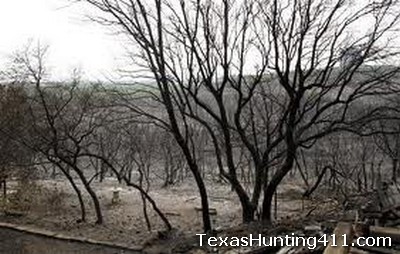Fire can be great for managing wildlife habitat. Wildfires start through natural processes and benefit native plants and animals in many ways. The impacts of wildfire on wildlife habitat are a positive, but in modern times wildfire is viewed as a negative. This is because property damage is involved and human lives can be put at risk. Wildlife biologist and habitat specialist realize that prescribed burning benefits both wildlife and people and it, unlike a wildfire, can be set and managed under a predefined set of environmental conditions.
The scarring left by wildfires that consumed more than a million and a half acres in Texas so far this year will continue to fade, according to Texas Parks and Wildlife Department (TPWD) biologists. The well-charred habitat will eventually be replaced by a landscape in much healthier condition for wildlife. Despite the hardship endured by those closest to the recent wildfires, time will eventually illustrate the positive ecological role that fire plays.

Habitat recovery depends on a lot of things, but the most important element is rain–something Texas has been running short on this year. Good rainfall can get things green in a hurry and have habitat off and running, but a lack of rain can delay plant and animal recovery for seasons and even years. Glen Gillman, one of TPWD’s Wildland Fire Program Leaders, stated:
“Following sufficient rainfall, recovery of burned vegetation will be fairly rapid. Wildlife species such as white-tailed deer will move back into burned areas. This may take longer in areas where brush species were hit hardest.”
Initial field assessments by TPWD biologists indicate minimal losses to wildlife populations from recent wildfires, although some mortality is to be expected during large scale fires, and plant communities are expected to recover over time. Individual ranches may see fewer animals until overall habitat conditions improve. Chip Ruthven, TPWD wildlife management area project leader in the Panhandle, said:
“Once rains come, forbs and grasses will respond quickly on most wildfire sites. Typically with spring fires warm-season grasses will respond better than forbs. Regrowth normally has a higher nutritive content and woody resprouts are more available for species such as white-tailed deer.”
Big game animals, such as white-tailed deer and pronghorn antelope, are capable of evading fire, burrowing animals can seek refuge underground and birds fly out of harm’s way.Even on ranches having high fences, deer usually can find an escape route. In fact, during a major fire that burned 95 percent of the high-fenced Chaparral Wildlife Management Area (WMA) southwest of San Antonio in 2008, relatively few deer were killed. Fast forward three years later and now deer densities on the WMA are a record highs!
The impacts of wildlfire on ground nesting bird species, like bobwhite quail and turkey, are tougher to project because nesting cover will take longer to recover. But, they do come back. Game bird species evolved with fire and are usually observed actively feeding in recently burned areas. Seeds become easier to find, but quail and turkey will not be nesting anytime soon.
The majority of Rio Grande turkeys probably did not even attempt to nest during the latest drought conditions, so the fire likely did not have a major impact on this year’s production. The greatest impacts of wildfires will be to reptiles and insect populations, both of which are capable of making rapid recoveries. You see, fires are a normal and natural process. Wildlife, and the habitats they depend on, have evolved with fire and, in the long-term, the effect of fires are quite positive. Just give it a little time–and some rain!